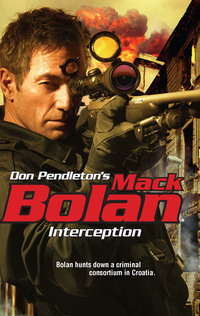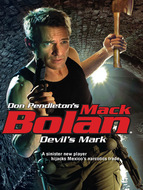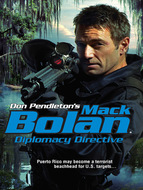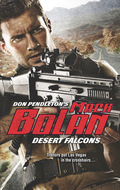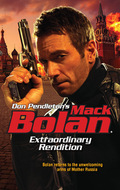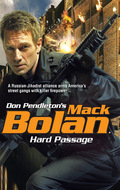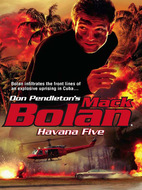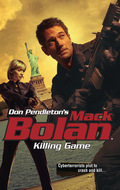Kitap dosya olarak indirilemez ancak uygulamamız üzerinden veya online olarak web sitemizden okunabilir.
Kitabı oku: «Interception»
Bolan cocked an eyebrow. “The Company asked for help?”
Brognola shrugged. “Their best operatives are running in Pakistan and Iraq these days.”
“So I’m supposed to enter a section of the city of Split that is a law unto itself. A place where everyone is pretending to be something they aren’t. Then I start following up leads to find two people who have disappeared, but whose disappearances may or may not be linked.”
Brognola nodded. “Yeah. That about sums it up. But don’t forget, if anyone suspects you’re an American agent, there are about one hundred intelligence and terrorist cells who’ll try to kill you.”
Bolan leaned back. “When do I leave?”
Interception
Mack Bolan®
Don Pendleton

Special thanks and acknowledgment to Nathan Meyer for his contribution to this work.
It is not the critic who counts, nor the man who points out how the strong man stumbled, or where the doer of deeds could have done them better. The credit belongs to the man who is actually in the arena, whose face is marred by dust and sweat and blood; who strives valiantly;…who knows great enthusiasms, great devotions; who spends himself in a worthy cause; who, at the best, knows in the end the triumph of high achievement, and who, at the worst, if he fails, at least fails while daring greatly.
—Theodore Roosevelt,
(1858–1919)
I’m not one to stand idly by while the bullies of the world intimidate the weak. It’s not in my nature—nor will it ever be. I’ll take my last breath defending America.
—Mack Bolan
To the men and women who defend our nation
CONTENTS
PROLOGUE
CHAPTER ONE
CHAPTER TWO
CHAPTER THREE
CHAPTER FOUR
CHAPTER FIVE
CHAPTER SIX
CHAPTER SEVEN
CHAPTER EIGHT
CHAPTER NINE
CHAPTER TEN
CHAPTER ELEVEN
CHAPTER TWELVE
CHAPTER THIRTEEN
CHAPTER FOURTEEN
CHAPTER FIFTEEN
CHAPTER SIXTEEN
CHAPTER SEVENTEEN
CHAPTER EIGHTEEN
CHAPTER NINETEEN
CHAPTER TWENTY
CHAPTER TWENTY-ONE
CHAPTER TWENTY-TWO
CHAPTER TWENTY-THREE
CHAPTER TWENTY-FOUR
CHAPTER TWENTY-FIVE
CHAPTER TWENTY-SIX
PROLOGUE
In Croat the name of the suburb was Trg Brace Radic, which meant Old Town. It was underpopulated, filled with ancient structures and isolated from the more urban areas of modern Split and in the shadow of the venerate Milesi Palace.
At that time of night it was a place where people minded their own business and kept to themselves. Inside an abandoned, rundown house Mack Bolan stood facing two men. One of the men was Andrew Vasili, a Croat intelligence official turned mercenary information broker, and the second was his bodyguard.
Vasili opened the envelope Mack Bolan had just handed him. The man ran a thick thumb over the neatly bundled packets of euros. He grunted to himself and nodded, satisfied with what he saw. He turned to his bodyguard and nodded again in a single, sharp motion.
The bodyguard removed his hand from the pistol grip of his silenced H&K MP-5 and reached into his coat pocket, withdrawing a silver flash drive that he handed to Bolan, who made it disappear like a stage magician.
Suddenly the glass shattered with a sound like ice in a whiskey tumbler. The shards flew through the air, then fell to the floor as the bodyguard stiffened. The man’s back arched and his eyes grew wide as the heavy-caliber round struck the flesh of his back with a wet, thick slap that was impossible to mistake.
A second later the report of the rifle rolled like thunder through the broken window and Bolan was on the move. The bodyguard turned as he fell, twisting with the force of the round and tumbling like a drunk on the deck of a pitching ship. Blood burst from his mouth in a violent cough as Bolan was dropping and going for his weapon.
Vasili, the informant, shouted as his bodyguard died, letting an expensive black attaché case drop like a stone to the filthy floor. Then he reacted with the honed reflexes of a man primarily concerned with his own survival.
The blood splashed Bolan’s face, warm and sticky and smelling of copper. He heard car tires crunch across gravel and the race of a vehicle engine. Crossing quickly to a second window beside the room’s front door, he parted the limp curtains. Outside a dented and grimy Stobart pickup with its lights off pulled to a stop in a short slide, raising a cloud of dust beside a long figure holding an SKS automatic rifle.
Asian men wearing green headbands and street clothes leaped from the back of the truck. Bolan counted four men, plus a driver and passenger in the front seat. That made seven with the first shooter. Time sped by like frames on a film reel. He saw a RPG-7 and a RPK machine gun standing out among the thicket of AKM barrels.
Of course, he thought to himself, turning. The exchange couldn’t have gone smoothly. It hardly ever did.
Bolan realized he and Vasili would never make it to the back door in time to save themselves if the hit squad was allowed to execute its plan unchallenged. He wasn’t sure who the team of assassins answered to, but it was obvious they had come loaded for bear.
Bolan would need to put a monkey wrench in their well-oiled machinery if he wanted to live.
The Executioner drew his Beretta 93-R and shoved the pistol through the cheap glass of the narrow window of the dilapidated and abandoned house the confidential informant had demanded as a rendezvous point. He cut loose, the 9 mm Parabellum slugs ripping out hard one after the other.
The Asian with the RPG-7 went down on one knee as a double tap struck him center mass. The hit squad responded instinctively to the ambush fire and scattered, their singled-minded purpose having been disrupted by Bolan’s aggressive action.
He kept pulling the trigger as he swept the belching muzzle of the machine pistol toward a hooded killer trying to bring the big RPK machine gun to bear. Bolan hit him in the shoulder, then skipped two more rounds past him and into the hood of the Stobart pickup.
An AKM assault rifle opened up from the squad, and 7.62 mm rounds burned through the stamped metal-and-plastic reinforced faux wood of the house’s battered door. Slugs whizzed into the tight living room, and then the RPK opened up. Bolan dived to the floor and scrambled down the short, narrow hallway that ran from the living area-kitchen to the single back bedroom.
Just ahead of him the Croat information broker crawled along the floor, as well, heading for the back door, which Bolan had jimmied to enter when he’d first arrived on the uncertain scene. A fusillade of metal-jacketed bullets tore through the fragile structure. Glass shattered as wood and plastic housing materials were shredded under the onslaught. Vasili’s black attaché case was ripped apart, and papers exploded into the air like ragged confetti. The furniture disintegrated as more heavy-caliber main battle rifles joined the barrage.
The RPK cut loose in long, distinct braps of fire as the machine gunner dragged the weapon along the length of the one-story house. A mildew-stained refrigerator was blown apart as rounds punched through the outside wall and bored into it like lead-jacketed sledgehammers. Bolan’s own carry-all, still resting on the kitchen table, was ravaged in a relentless cross fire, and his expensive electronics were pounded into useless, unrecognizable pieces. The machine gun severed the door from its hinges and the perforated structure blew inward.
A green tracer round struck a cushion, igniting a small fire on the ratty couch. A cheap clay vase, empty of flowers, was shattered and another ComBloc tracer round sliced through the flimsy window curtains and set them on fire.
In the hall Bolan scrambled to his knees as Vasili reached up and opened the back door. The big American’s ears were ringing from the furious din, and he knew it would only be moments before another gunman in the death squad retrieved the fallen RPG-7 antitank weapon and turned it on the single-story home.
Vasili pushed open the back door and jumped out of the house over the short porch steps and onto the ground. Bolan leaped up after the man and followed him out the door. What happened next unfolded too quickly for Bolan to consider; he merely reacted on instincts so finely honed by continuous exposure to violence that they were evolved to nearly preternatural levels of capability.
The leader of the death squad had placed a security gunner on the rear door in a textbook setup. Bolan spotted the muzzle-flash from the weapon of an Asian killer lying in a shallow depression beside an old metal trash barrel. The man’s bare arms were alive with brightly colored tattoos, indicating his affiliation with either the Japanese Yakuza or one of the Hong Kong triads. Bolan had an impression of a burst hitting Vasili and the Croatian criminal shuddering under the impact. As he heard the sound of the gunfire, the Executioner was already twisting in midair. His feet hit the ground, and he sank into a crouch to absorb the impact, his pistol firing a triburst on the fly.
The sniper’s head jerked back and his green head-band lifted off with a Frisbee-like section of skull and went spinning away into the bushes by a low stone wall. The man’s ruined head slumped into the dirt, and Bolan sprang forward out of his crouch. His feet pounded hard against the brown grass of the tiny back lawn as he sprinted the fifteen yards to the downed enemy gunner.
Bolan slid into place beside the corpse and from behind him the house rocked on its ancient foundations as the RPG-7 warhead exploded inside. Jets of flame erupted from shattered windows and the open door. Within seconds, oily smoke poured into the night sky, and a wash of heat rolled into Bolan like a furnace blast. He felt a sting of piercing impact on the big muscles of his shoulder and a distant part of his mind cataloged the shrapnel wound.
Reaching down with his left hand, he grabbed the bloody hit man’s limp arm. He rolled the dead man over as he slid the still smoking Beretta 93-R into the waistband at the small of his back. The barrel was warm on his skin. He snatched the AKM used to gun down Vasili and then pulled a Croatian army grenade from the ammo pouch on the fanny pack belt cinched around the dead man’s waist. The canister-shaped device was an RG-42 antipersonnel hand grenade, 4.6 inches long and it weighed 436 gms. The deadly little bomb had a blast radius of 75 feet and had come from Soviet stocks when Split had still been Yugoslavia. Bolan thought it felt damn good in his hand.
The Executioner rested the AKM assault rifle across his knee and jerked the pin from the hand grenade. He grabbed the Kalashnikov and rose, the fingers on his left hand holding down the safety lever on the grenade. He felt the blood from his shoulder wound roll down his back, sticking his shirt to his skin.
Bolan realized speed and aggression were his only allies now. He jogged toward the corner of the smoldering house. As he reached the front of the structure, he released the lever on the hand grenade and the tightly depressed spring shot the metal strip out into the air away from him. Bolan slowed to a walk and peered around the final corner, the grenade cooking off in his fist.
He saw the death squad approaching the door of the smoke-filled house, arrayed in an inverted V formation like geese flying south for the winter. The driver of the Stobart pickup remained behind the wheel of the running vehicle. Bolan tossed the grenade underarm toward the mysterious Asian death squad. It bounced once and rolled toward the team like a can of soda spinning off a desk and across the floor. One of the gunmen caught the motion and turned, his AKM coming up.
Bolan snapped his hand onto the front stock of his own AKM as he pulled the weapon’s trigger. He scythed the man to the ground, then peeled back around the corner of the little house, feeling the heat from the fire burning inside against his back. He heard men scream in warning then the grenade blast silenced them.
Angry hornets of shrapnel rattled into the ruined building and buzzed through the smoky air. Bolan rolled back around the corner of the house, snuggling the AKM into the crook of his shoulder like a man hugging an old friend.
The hit team lay on the ground. Some men tried to sit up while others reached frantically for weapons knocked clear by the blast. Bolan raced forward and opened up with controlled sweeps of the AKM muzzle, hosing them down. Spent shell casings arced out of his weapon until it ran dry.
Bolan threw aside the hot, smoking assault rifle and reached for the Beretta 93-R secured behind his back. He spun toward the pickup, falling into a modified, two-fisted Weaver stance with the machine pistol.
The driver had already thrown open his door and jumped from behind the wheel. But, like the rest of the hit squad, the man had brought an AKM assault rifle for the attack and the long weapon banged against the steering wheel and the side of the cab as he tried to yank it free and bring it into play.
Bolan put four rounds through the gap of open vehicle door and windshield in less than a second. All four 9 mm Parabellum rounds found their mark and the man staggered back, dropping the rifle so that it clattered off the truck and onto the ground. Blood rushed in a river from the gunner’s ruined throat and jaw as he spun. His feet tangled up in themselves and he went down without a word to bounce hard off the blood-splattered cobblestone.
Senses amped to a peak level by adrenaline, Bolan heard a moan at his feet, turned, dropped his pistol muzzle and put a bullet in the man lying there. Then he started toward the still running Stobart pickup. He dropped the 93-R pistol’s magazine from the butt grip and slammed home one of his two backups. His finger found the catch release and the handgun shuddered in his hand as the bolt slid home and chambered a round.
Bolan climbed into the pickup and slammed the door closed. He stood on the gas and cranked the wheel hard, turning the vehicle in a tight circle and leaving rubber skid marks across the pavement. As he straightened the nose of the European pickup back toward the road, his front tire rolled over the body of the driver he’d killed with the 9 mm pistol.
The steering wheel shuddered in his grip as first his front and then his rear tires rolled over the body. Without a backward glance, Bolan sped away into the night.
JACK GRIMALDI had the sleek Saber jet running flat-out over the Atlantic Ocean.
In the back of the private, executive-class plane Mack Bolan had dressed his wounds, then cleaned up and changed clothes. Immediately upon takeoff he’d dumped the contents of the flash drive he’d purchased from Vasili into an Epsilon Protocol Encryption laptop provided to him by Stony Man Farm’s mission controller, Barbara Price.
The powerful little computer had downloaded, security checked, encrypted and sent the information contents of the flash drive to Stony Man’s mainframes via Keyhole satellite. Now, an hour later, Bolan had just popped the top on a cold beer to wash down a fistful of ibuprofen tablets when the call came in.
“It’s Barb at the Farm,” Grimaldi called through the open cockpit door. “There’s been an update from that Croatian information you passed on.”
Bolan placed his beer on a nearby table after swallowing his antiinflammatory pills, then picked up the secure satellite phone lying next to him.
“Go ahead,” he said.
“Striker,” Barbara Price said. “I’ve already given Jack new coordinates. We learned something urgent from that file you gave us. Something new has come up.”
“When doesn’t it?”
He felt the plane shift course as Jack Grimaldi cut the Saber jet onto new coordinates.
And so it began.
CHAPTER ONE
Mack Bolan jumped from the jet at forty-five thousand feet, opened the canopy high and sailed miles in from out over international waters. He wore a thermal suit and used supplemental oxygen to help him withstand the rigors of high altitude.
Over time the Executioner had come to excel in such airborne insertion operations. The nature of the deployment was such that stealth was an even higher priority than the lightning-quick speed of heliborne and fast-boat delivery methods. Often it was by high altitude low opening—HALO—jumps. He’d leave the jump plane at up to thirty thousand feet then free fall down to a height of fifteen hundred to a thousand feet, waiting until the last possible minute to deploy for short exposure over the target.
In the HALO jumps, as in this instance, Bolan’s insertion relied not only on the extreme altitude of the plane, but on great, even vast topographical distance, as well.
THE COUNTRY WAS an armed camp. North Korea contained a civilian population motivated and conditioned to a degree of loyalty not seen since the Spartans. To help ensure Mack Bolan’s probability in remaining uncompromised by a chance encounter, Stony Man Farm, under mission controller Barbara Price’s direction, had picked a landing zone in a remote section of very rugged terrain in the mountains above the objective. After being outfitted at a Joint Special Operations Command forward operating base in Djibouti on the way in, Bolan was now dressed in complete tree/cliff landing gear: padded suit, football-style helmet with full face mask, reinforced ankle guards. The Farm’s planning called on him to make a tree landing in an isolated valley, rappel from the canopy, then make his way down a steep crevice and into the Yellow River tributary.
He carried nearly two hundred pounds of mission-essential equipment, weaponry and survival gear for the operation. The mission plan called for infiltration into the site by means of the river, so he jumped with a Draeger Rebreather scuba system. Such an ops plan was horribly “Hollywood” in execution as such a plethora of skills and independent stages greatly increased the operative’s exposure to the double threats of military SNAFUs, including the omnipresent threat of a mission-ending injury.
Given the choice, Bolan would have preferred walking in, cutting through the DMZ to the south by means of routes already secured and verified by Special Forces teams assigned full-time to covert LRRP/SU ops in the no-man’s land between the north and south of the Asian peninsula.
But as happened so often when Stony Man Farm and the Executioner were called into play, the operation depended on complete invisibility while at the same time remained hamstrung by timing. The train Bolan intended to intercept was going to be on target on time, and only for that time. The Oval Office wanted a surgical strike with no collateral damage.
The land was arrayed below the plummeting commando in an uneven checkerboard of blacks and grays. He flared his canopy hard at the last moment, attempting to curtail his momentum as the ground rushed up. He heard then felt his rucksack crash into the copse of trees, then two heartbeats later his feet, tightly clamped together, broke through the mesh of interwoven branches at the top of the canopy. He kept his legs pressed together as gravity yanked him down through branches and tree trunks. He took several bone-jarring impacts before his parachute caught and his neck whip-lashed hard into the special support collars leaving him sore but unharmed.
Taking stock of his surroundings, he looked down and saw he was about forty feet from the ground, caught halfway up a good-size evergreen. His chute seemed securely trapped above him, but he was too far out from the main trunk for the branches to have enough girth to support him.
Hitting his quick-release clip, Bolan let his rucksack fall, then pulled himself along the branches of the pine tree until he was on a more stable support. He disengaged the jump harness and secured his nylon ribbon of a rappel cord from a pocket in the lower leg of his padded suit.
He slipped the strong, flat cord through a D-ring carabiner positioned at his waist and kicked away from the tree, dropping to the ground in a smooth arc. On the forest floor he quickly removed his jumpsuit, helmet and supplemental oxygen along with the rest of his rappel harness. He made no effort to retrieve his chute and paid only cursory attention to camouflaging the gear he was leaving behind. If there was anyone close enough to stumble onto it in the dark, then the mission was probably blown in any case.
From his pack Bolan secured first his primary weapon, a Chinese model AKM with folding paratrooper stock, and a night-vision-goggle headset. Like a modern-day version of the childhood boogeyman, he hunted at night, could see in the dark and was armed with fearsome claws. Straining against the weight, Bolan slipped into the shoulder straps of his rucksack then took first a GPS reading before double-checking his position with a compass to verify his start point. Satisfied, he set off down the steep, narrow valley toward the dull gleam of the wide river below.
In many ways his cross-country navigation was almost more dangerous than the HAHO jump, or even than the potential difficulties he faced in his coming swim. Every model of night-vision device available offered depth perception difficulties. The scree-covered terrain was rocky and steep, making his footing uncertain, and he was cutting down not an actual path but rather a rain wash gully. With two hundred pounds on his back each step downhill sent a biting jar through his knees and lower back, threatening to turn his ankles constantly as his heels came down on loose gravel and powdered dirt. The topography was so steep and uncertain Bolan spent half the two-kilometer descent sliding on his backside as opposed to on his feet.
By the time Bolan reached the floor of the wash he was drenched in sweat and breathing hard. He squatted among the cover of some weeds and cheat grass behind a row of dense shrubs well back from the two-lane blacktop that ran parallel to the river, resting long enough for his heart rate to recover and his breathing to even out. He washed down a couple of the “Go” pills the military gave their pilots on long flights with a full canteen of water. He then opened his rucksack and broke out the dive gear. By his watch he noted he was seven and a half minutes ahead of his pre-op planned time schedule.
With such a strenuous overland hike and steep descent he had been unable to don his wet suit until just prior to submersion or risk heat fatigue and dangerous dehydration. He quickly stripped and donned the neoprene wet suit. Once he was dressed, he pulled on North Korean army fatigues over the insulated swim gear and retied his combat boots.
He was stripped down to the essentials for his swim, and other than his primary weapon everything he needed was tightly fitted inside an oversize butt pack or secured across his body in the numerous pockets of his fatigues or pouches on his H-harness web gear.
Working quickly he fit the poncho-style vest of the rebreather system over his head and shrugged it across his shoulders before pulling the neoprene hood of his wetsuit into place. He fit the mouthpiece and tested the oxygen circuit. Designed for short, shallow dives, the rebreather offered scuba capabilities while eliminating the telltale trail of bubbles of other commercial diving rigs.
Holding his facemask and swim fins in one hand, Bolan cradled his primary weapon in the crook of his arms and crawled out from his place of concealment and into the mouth of the metal culvert running under the North Korean highway.
Coming out the other side, he slid into the cold, sluggish water of the Yellow River with all the deadly, fluid agility of motion as a hunting crocodile. Once in the water he spit into his mask and rinsed the faceplate before putting it on and then tucked his swim fins into place around his boots.
Submerging into the frigid and inky black he began kicking steadily into the middle of the deep river where the current was strongest. Staying about two yards below the surface, he used the luminous dials of his dive watch to judge the approximate distance of travel.
Bolan surfaced after fifteen minutes and stopped kicking, letting the current carry him in among the heavy beams of the crossed pillars supporting a railroad bridge across the river. Working quickly, he stripped his dive gear and let it float down into the cold gray appetite of the water. Reaching up, he grabbed hold of a wide crossbeam and began to climb.
He pulled himself up, hand over hand, twisting around the cross beams and climbing higher and higher. Above him the horizontal beams housing the tracks grew closer and closer and the wind picked up the nearer he drew to the lip of the canyon. He climbed with his Kalashnikov hung muzzle down across his back, and by the time he reached the top the water had stopped dripping behind him. He double-checked his watch and crawled into position, fitting himself tight into the trestle joist.
Intelligence stated that the protocol for all military rail transports leaving the Yellow River Restricted Military Zone stopped on the other side of the bridge to allow for routine security inspections of transport documents. There were schedules to be kept, protocols to be followed, routines to be adhered to. He would have the three-minute window it took for the brakeman to change the tracks to get out from under the bridge and onboard the train without being seen by the armed sentries of the Army of the Democratic People’s Republic of Korea, the DPRK.
The time frame itself was ludicrous enough, as any delay along the way could have thrown the whole operation into jeopardy, but such a tight schedule hadn’t dissuaded Bolan, and Stony Man hadn’t apologized during his initial briefing.
The Executioner focused wholly on the task ahead of him and with the patience of a trapdoor spider as he lay in wait as the North Korean freight train approached then skidded to a stop in a shower of sparks and the harsh squeal of steel-on-steel. Spotlights glared down the length of the track as the military checkpoint on the far side of the bridge followed their established practice. This night the institutionalized paranoia of the DPRK would prove well founded.
Bolan scrambled up through the girders and pulled himself onto the train track. He looked down the serpentine length of the transport train toward the lead engine and saw two men in heavy military overcoats climbing into the engineer’s compartment. The searchlight mounted at the top of the checkpoint shack began to rotate and play along the length of the train.
Bolan began to move fast.
He scrambled up next to the coupling housing between two railroad boxcars and out of the path of the advancing searchlight. The powerful beam of illumination ran down the train, and Bolan shrank back into the protective enclosure of the railcar’s shadow. Once it was past, he scrambled upward, climbing smoothly until he reached the apex of the boxcar.
At the summit he slid over the end of the train and quickly scanned in both directions. Five cars down there was a gap between the roofs of the olive-green boxcars, indicating a flatbed railcar. Beneath him the train began to sway as the brakes were kicked off and the engineer let go with a whistle blast to signal the imminent movement of the long train.
The industrial locomotive lurched to a start and began to gather speed, slowly at first but then with greater and greater momentum as the train began to push forward. Bolan hugged the roof as the train moved past the checkpoint and plunged into the sharply mountainous countryside beyond the river. He clung precariously for several minutes as the train finished gathering speed and began placing more and more distance behind it from the access station out of the restricted area.
Finally ready, Bolan lifted up off the roof of the boxcar and began to navigate his way down the line of cars.
THE MISSILE COMPONENTS were housed in wooden crates, but there was no disguising them if a person knew what to look for. The main crates were thirty-two feet long, holding the medium-range intercontinental rockets while additional storage boxes housed the powerful engines and the advanced computer guidance systems inside the conical tips. Stony Man intelligence had them en route to Pyongyang and from there to Iran by freighter.
The Executioner had been deployed to send a message about the traffic of such advanced and powerful weapon systems, and he carried enough Semtex explosives in his kit to guarantee there would be no misunderstanding.
From his position on the boxcar overlooking the flatbed where the pyramid stack of rockets had been secured, Bolan was able to count four guards. The train was traveling at full speed now and the mountain winds were bitter and harsh, driving the sentries into sheltered alcoves. Bolan felt confident he could place his demolition charges unobserved.
He moved quickly, sliding down the iron ladder built into the boxcar. He landed on the access platform just as a fifth soldier, with NCO markings on his uniform, came around the edge of the car on the signalman’s catwalk.
The man was shorter than Bolan by half a foot, stockily built with high, flat cheekbones and dark brown eyes that widened almost comically in surprise at the sudden apparition of a dark-clothed Occidental. The man clawed for a 9 mm Tokarev TT30 pistol as Bolan, hands empty, leaped forward.
The man managed a short bark of surprise before Bolan struck. Lunging forward, the Executioner lifted his left knee to his chest and kicked explosively, driving the heel of his combat boot in the man’s chest and driving him backward over the railing of the catwalk.
Ücretsiz ön izlemeyi tamamladınız.
